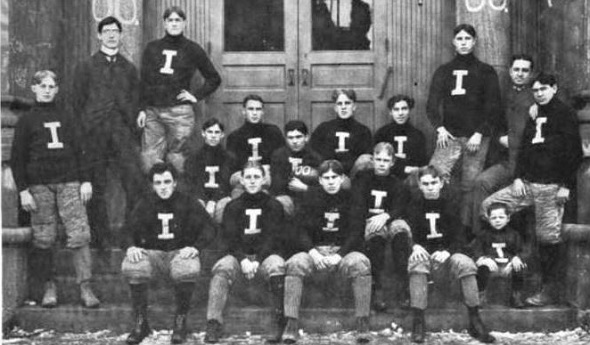
Forgotten Series Named 1st Grid Champs
November 29, 2016
By Ron Pesch
Special for Second Half
“In the first decade of this century, there were some very, very unsavory things going on in high school sports," said MHSAA sports historian Dick Kishpaugh back in 1999. "Though teams used school names as if they represented their high schools, schools didn't set policy, players did. … Serious injuries were common, gamblers arranged games, and shady recruiting practices were the norm.”
On March 31, 1899, at the Michigan State Teachers’ Association meeting hosted in Ypsilanti, discussion took place about a proposal that had been put forth by some high schools. The request was to form a statewide “conference with a view to arranging (a) series of base and football games between those schools which adopt the rules.”
Speaking in 1907, Herbert W. “Buck” Read, a coach at Kalamazoo Central High School (and later head basketball coach at modern-day Western Michigan University) recalled the purpose of the plan was “to do away with the chaotic state of affairs then existing in high school football circles” as teams and communities jockeyed for superiority and arranged games that did little more than create an “opportunity to those of betting proclivities.”
The proposal advanced to the Association’s High School Athletic Committee. There, a plan was formed for a playoff system designed to identify a state football champion. The system would be governed by the Committee and run by the Interscholastic Department of the University of Michigan Athletic Association. The playoffs would then culminate with a championship game played at the university on Thanksgiving Day.
By late summer, it was decided to broach the subject with Michigan’s schools.
As Lewis L. Forsythe noted in his book, “Athletics in Michigan High Schools: The First Hundred Years,” the prosperity of the Technological Revolution, combined with the fact athletics were achieving new popularity in colleges and schools, helped propel expansion of athletic activities across the nation.
At the time, there were 165 high schools in incorporated cities and villages with populations of 1,000 or more scattered across Michigan. Only 72 enrolled more than 100 students (including girls).
A League is formed
Letters were sent to state high schools, offering application for membership in this new Michigan Interscholastic Athletic League. While a number of schools opted to remain independent, by deadline, there were 42 teams accepted into the “Interscholastic.”
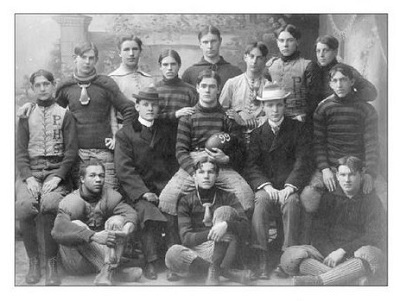 The state was divided into six geographical “sections” and “sectional” games were arranged by the league, designed to allow for sectional championship contests to be scheduled for Nov. 9. District championship title games, designed to produce a Western division and an Eastern division champion, were scheduled for Nov. 23. The state title game between east and west was then scheduled for Thanksgiving Day at the University of Michigan’s Regents Field.
The state was divided into six geographical “sections” and “sectional” games were arranged by the league, designed to allow for sectional championship contests to be scheduled for Nov. 9. District championship title games, designed to produce a Western division and an Eastern division champion, were scheduled for Nov. 23. The state title game between east and west was then scheduled for Thanksgiving Day at the University of Michigan’s Regents Field.
Complications quickly surfaced. Transportation at the time was primarily by rail or trolley line, and many teams had to travel a fairly great distance to face scheduled league opponents. Almost immediately, some schools dropped out of league play or forfeited games because of travel expense.
Still, 33 games were played by the high school teams belonging to the “Michigan Interscholastic Football League.” Pontiac, which defeated Bay City in the semifinals, emerged as the state’s first playoff champion with a thrilling 6-5 victory over Western representative Plainwell before a reported crowd of 1,000. Plainwell had downed Escanaba in the semis to reach the final game.
U.P. Power
Because of the complications, talk of disbanding the league erupted in the media. But, with some minor modifications, including more local control over scheduling, the playoffs were again planned for the fall of 1900.
Ishpeming and the Michigan Military Academy of Orchard Lake emerged from a field of 34 teams to square off for the title at Regents Field. In a battle of “speed against weight,” the boys from the Upper Peninsula, averaging 135 pounds, completely outplayed their heavier opponent, and grabbed a 12-5 win. According to The Michigan Alumnus, financially, the event lost money, as a crowd of only around 300 attended the title game. Still, the university saw the “Interscholastic” as a success. According to the university’s annual, Michiganian, during the season, the Athletic Association was forced to apply “some severe measures in its governance of the football contests, thus showing members of the league that they must learn to be square and businesslike.”
On the other hand, the championship contest served as a great opportunity to expose athletes to the campus. Without question, recruitment of future university athletes was an underlying desire. Anderson of Ishpeming was identified as the top player of the day. According to the Alumnus, “Michigan needs a few such as he.”
By mid-November, the 1901 interscholastic series saw the race narrowed to Kalamazoo, Lansing, Orchard Lake, Ann Arbor, Alpena and South Haven in the Lower Peninsula, while Ishpeming, which knocked off Escanaba 11-0, had emerged again as the Upper Peninsula champion. Ultimately, Kalamazoo downed Lansing on Thanksgiving Day to set the stage for the title game on Saturday, Dec. 7.
Although cost concerns related to bringing Ishpeming to Ann Arbor threatened to derail plans for the championship game, the contest was played. In a close battle, the faster Ishpeming squad again prevailed, 27-21. The team returned to the U.P. to a great reception. According to the Detroit Free Press, “a procession was formed at the depot with the footballists occupying seats on a chariot. … Mine whistles and bells of the city sounded for thirty minutes, while thousands of school children and others gave school yells.” It was estimated that 8,000 fans came out, making a procession six blocks long.
In 1902, Escanaba nearly ended Ishpeming’s championship reign, as the teams played to a scoreless tie in early November. However, ties in Interscholastic League action meant the game had to be replayed. Ishpeming downed Escanaba, 11-5, in the rematch and again returned to Ann Arbor for the championship game. There they flexed their speed and skills in a 35-12 victory, this time over Lower Peninsula champion Benton Harbor in a game played at Michigan’s Ferry Field. A total of 34 high schools participated in the Interscholastic League that fall.
Financial challenges and eligibility questions
Benton Harbor returned to the championship game in 1903 with a squad averaging 160 pounds, unusually heavy for the time. Up north, Escanaba defeated Ishpeming 34-2 to punch its ticket to Ann Arbor. The state championship contest, played on Thanksgiving Day, was one-sided and decisive as Benton Harbor rolled to a 22-0 victory. According to press reports, at no time was their goal line “in danger.” The championship series, however, was threatened as university officials again declared the title game was simply unprofitable as travel costs outweighed ticket revenue.
Still, another attempt was made in 1904 as 46 schools, 29 from the Lower Peninsula and 17 from the U.P., opted to battle for the Interscholastic football crown. League contests opened Oct. 1 with the Lower Peninsula championship game scheduled for Nov. 19. Many schools, especially in the larger cities, continued to avoid participation, due to the inconvenience of arranging contests around Interscholastic dates, as well as the simple fact that more revenue could be generated by playing local or familiar opponents.
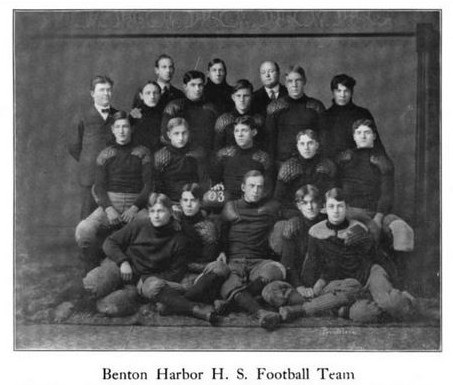 In a major upset, Mount Pleasant won the 1904 Lower Peninsula championship honor by downing heavily-favored Benton Harbor 11-0 at Fancher Field in Mount Pleasant before a crowd of 1,800. Five passenger coaches, filled with Benton Harbor fans and a band, made the trip north for the early morning game. Fred Norcross, quarterback and incoming captain of the University of Michigan football team, was also in attendance. Quoted in the Michigan Daily, he lent some insight into the way the game was played at the time.
In a major upset, Mount Pleasant won the 1904 Lower Peninsula championship honor by downing heavily-favored Benton Harbor 11-0 at Fancher Field in Mount Pleasant before a crowd of 1,800. Five passenger coaches, filled with Benton Harbor fans and a band, made the trip north for the early morning game. Fred Norcross, quarterback and incoming captain of the University of Michigan football team, was also in attendance. Quoted in the Michigan Daily, he lent some insight into the way the game was played at the time.
“It was a good clean game, free from slugging and unnecessary roughness, and the way the Mt. Pleasant boys worked to help the man with the ball along was great,” he said. “They would drag a man five yards after he was down.”
Escanaba, a 12-6 winner over Menominee, earned the U.P. crown. The Interscholastic championship game at Ann Arbor on Thanksgiving Day was surrounded with controversy. Just prior to the game, a protest had been raised by Benton Harbor with claims that Mount Pleasant had used an ineligible player in their contest. Bay City, defeated by Mount Pleasant in Interscholastic play the previous week, joined the protest. The complaints, it appears, were dismissed, as Escanaba defeated Mount Pleasant 16-5 for the state title. Following its school’s defeat in the title contest, the Mt. Pleasant Courier “denounced the Escanaba team as having three ineligibles.”
Following the game, newspapers reported that both Detroit Central and Muskegon finished the season undefeated and were considered outstanding teams, but since they did not compete in the Interscholastic series, both were unable to lay claim to the official state title.
Tightening the rules
Perhaps as a result of questions concerning eligibility that surrounded the previous season, the 1905-06 school year brought changes. The management duties of the Interscholastic Athletic League now fell into the hands of a state “Athletic Director,” the duties of which were assumed by Principal C. G. Wade of Flint. A tightening of regulations and rules tied to management of high school athletics in Michigan also were enacted. Very specific requirements for enrollment, age and allowed number of years of eligibility were defined. Players could not be compensated for their athletic skills. Transfer between schools now required certification of eligibility from a superintendent or principal before a student was allowed to compete at a different school. Football players needed to pass a physical examination and have parental consent to compete. Passing marks, as defined by the school, were now a requirement for play.
Participation decreased as some of the state’s larger schools joined the League.
“What is the matter with the high schools of the third inter-scholastic district?” asked a writer in the Benton Harbor News-Palladium at the beginning of the 1905 season when it was announced that only three teams – Benton Harbor, Plainwell and Allegan – would compete in their section of the Interscholastic League. “Where is Kalamazoo? Is South Haven afraid? Does Hastings know anything about football? Why don’t St. Joseph enter the race? What is the matter with Cassopolis and the other places in the district …”
The tournament fell into disarray in the final weeks of November. Ishpeming was identified as the U.P. champion, but as of Nov. 24, it appeared that the state title would not be decided. Frontrunners for the Lower Peninsula crown were Ann Arbor and Grand Rapids Central, but the schools couldn’t come to an agreement on a location for the game. A ruling by director Wade identified Grand Rapids as the proper venue, but Ann Arbor felt the game should be played locally.
Then Kalamazoo High School announced it felt it should be the team playing Ann Arbor for the Lower Peninsula crown as it had beaten Grand Rapids earlier in the year. With an undefeated and unscored upon record, Kalamazoo should be an obvious choice.
Wade noted that while Kalamazoo had impressive record, the school had chosen not to participate in Interscholastic League play. Since the game with Grand Rapids was not considered an Interscholastic contest, the loss didn’t affect Grand Rapids’ pursuit of the League title.
Finally, since Ann Arbor refused to travel, it were forced by the league to forfeit the semifinal game. So, a championship contest between Grand Rapids and Ishpeming was scheduled.
Plans to play the game at Ann Arbor, announced earlier in the season, were scuttled and the contest was scheduled for 10:30 a.m. at Ramona Park in Grand Rapids. The Upper Peninsula again emerged as champion, as Ishpeming exposed a weak Grand Rapids defense and posted a 17-5 victory. The move of the game to the site of one of the participants appeared to be a wise one, as 800 paid admissions were collected.
(In an interesting turn of events, Ann Arbor opted, instead, to play a Thanksgiving Day road game with Kalamazoo High. Kalamazoo downed Ann Arbor 16-0 to finish the year as the state’s first unbeaten, untied and unscored upon team.)
The format unravels
Nationally, the brutality and danger of football was being discussed, and calls were to ban the game. President Teddy Roosevelt heard the cries and convened a panel of football authorities to investigate and suggest changes to save the game he loved. In 1906, sweeping alterations to the rules were unveiled and opened the game to the forward pass.
That fall, Muskegon and Benton Harbor emerged as finalists for the Lower Peninsula title. Muskegon had defeated Benton Harbor earlier in the season; however, in a twist of league rules, since the game had not been scheduled by the League office, the result of the contest had no impact on the championship series. After much debate over location and selection of officials, a record-breaking crowd of 1,500 was expected in Muskegon for the rematch, as the implications from a victory drew interest well beyond the borders of both cities. Extra streetcars were scheduled to move the crowd to the site of the contest, and the newspaper social pages were filled with reports of folks heading to Muskegon for the game.
Outplayed and out punted, the “Red and White of Muskegon” fought to the finish before a crowd of “about 1,600 paid admissions,” but fell 20-0 to the “orange sox” of Benton Harbor. The visitors capitalized twice on Muskegon fumbles, scoring a touchdown early in the game and another off a mishandled punt.
Revenue of over $500 (equaling around $13,000 in 2016) was generated from ticket sales. With expenses of around $175, including the $125 paid to Benton Harbor management, organizers were pleased. The following week Benton Harbor agreed to bear the expense if Escanaba would “defend the championship of the Upper Peninsula” in a Saturday, Nov. 24 game to be played in Benton Harbor, with University of Michigan officials in charge.
The Escanaba team left Wednesday for the event and arrived on Friday. The visitors ran through signals at Benton Harbor’s Fourth Division Armory before retiring for the night.
“Before a madly enthusiastic throng of three thousand spectators, Benton Harbor ran wild, overwhelming their guests from Escanaba, 50-0.
More complications
Still, dissention surfaced. Officials at Muskegon High School announced plans to resume playing an independent schedule in 1907, due to concerns about play of ineligibles appearing in its game with Benton Harbor the previous year, and ringers appearing in a spring baseball championship sponsored by the Interscholastic. A newspaper article in October noted the league was down to three teams: Ann Arbor, Saginaw and Benton Harbor. According to a report in the Muskegon Chronicle, the “arbitrary manner in which the executive committee arranged games” was stated as the primary reason the League was disfavored. Because of this, it was generally expected that the Interscholastic League would wither and die within a year.
Yet by season’s end, Muskegon was involved in the mix for a state title.
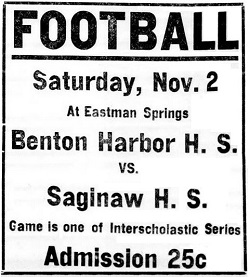 After three contests, it appears “the Red and White” had a change of heart and applied for membership in the Interscholastic League. As of Nov. 7, six teams were still in the state title race: Alpena, Saginaw, Muskegon, Big Rapids, Ann Arbor and Lansing.
After three contests, it appears “the Red and White” had a change of heart and applied for membership in the Interscholastic League. As of Nov. 7, six teams were still in the state title race: Alpena, Saginaw, Muskegon, Big Rapids, Ann Arbor and Lansing.
In a bizarre twist, Muskegon’s later application and delays in paying a $12 membership fee to the League became the pivot point in the Interscholastic’s next move. According to a Nov. 14 Detroit Free Press article, “the question of Muskegon’s eligibility to compete for the state high school championship had been deferred (until a state board meeting) and that Saginaw would therefore play Ann Arbor. …The winner of this game will play Muskegon, if the latter is admitted, in the final of (the) state series.”
Ann Arbor High School, which had beaten Muskegon earlier in the year and stood unbeaten and unscored upon, was extremely upset by the decision. Ann Arbor now had to face Saginaw, also unbeaten, with the winner still facing the possibility of meeting once-beaten Muskegon.
A bizarre safety assessed against Ann Arbor in the final minutes of its battle with Saginaw made matters worse. Leading 6-5 near the close of the contest, an Ann Arbor player fielded a bounding punt, “lost his head” and “deliberately ran back (of) his own goal line,” where he touched it down “instead of trying to make a gain or calling ‘down’ when he picked up the ball.” The two points awarded to Saginaw were all that were necessary to win.
With that victory, many felt Saginaw had gained rightful ownership of the Lower Peninsula title. The state athletic board of control, at its meeting in Ann Arbor, formalized Muskegon’s acceptance into the Interscholastic, and voted to give Muskegon, as a member, the right to demand a game with Saginaw. Noting the earlier Ann Arbor loss, the board also suggested that, in the interest of true sportsmanship, Muskegon should concede the state crown.
Muskegon High School officials contacted Saginaw and did concede the Lower Peninsula title, but still requested a game.
Casting aside the format of past Interscholastic championships, Saginaw did not play the Upper Peninsula champion, Escanaba, but rather accepted the Muskegon challenge.
Some 400 Muskegon enthusiasts brought to Saginaw by train helped form the largest crowd ever at Recreation Park, estimated at 5,000. In the end, disappointment reigned on both sides as the contest ended in a scoreless tie.
Following the showdown, the Upper Peninsula media weighed in.
“The recent dispute between the high school football teams of Escanaba and Saginaw over conflicting claims to the state championship has caused much discussion, but as there exists no court for the decision on a controversy between an upper and lower peninsula athletic team, the matter will very likely die as it is at present and the state will have two champion football elevens,” stated the Hancock Journal.
According to the Sault Ste. Marie Evening News, Michigan needed a state interscholastic athletic association, and “it is evident that until some such organization is formed, there will be no deciding of a championship in case of contention from any of the teams in the race.”
At the conclusion of the season, “Buck” Read spoke about the failure of the Interscholastic as time went on.
“The interscholastic divided the state into sections, played the winners of the sections against each other, and finally by a process of elimination managed to arrive pretty closely at the real championship,” he said.
“The plan looked good on paper, and as long as the university exercised a direct regulation particularly in that game which was for several seasons played at Ann Arbor, the interscholastic awakened a general, definite interest. But a season prosecuted under such an uncertainly arranged schedule, as was necessarily the case, proved unusually ruinous financially to the schools participating. Often a match had to be played between towns several hundred miles apart, entailing great expense, and often providing a poor drawing card when one of the contestants was a team ordinarily of little reputation. So a number of the bigger schools drew out and arranged schedules on a financial basis. The university authorities too, finally refused to guarantee the concluding game.”
One last gasp, and a new beginning
Somehow, the Michigan Interscholastic League survived for another season, although with few participants.
Ann Arbor, led by three touchdowns from future U-M great John Maulbetsch, earned the League title, upsetting Benton Harbor, 16-5, at University of Michigan’s Ferry Field. Pontiac and the Detroit University School, teams with outstanding undefeated marks, then clamored for a chance to play Ann Arbor.
Both had competed outside the M.I.A.L. during the 1908 season. Ann Arbor ignored Detroit University School, likely the stronger of the two teams based on season results, and scheduled a contest with Pontiac for Thanksgiving Day. The game was won by Ann Arbor 24-0.
At the Schoolmasters’ Club meeting on April 2, 1909, the High School Athletic Committee addressed the broadest issue that the Michigan State Teachers’ Association faced. It was recommended “there be formed a State organization to be composed of all high schools of the State that will sign an agreement to abide by the laws passed at the meetings of the Schoolmasters’ Club.”
It is also recommended to the committee, “that (athletically) a full schedule of all the schools in this organization shall not be made but that the different schools make out their own schedule and from such schools in the organization as they most prefer.”
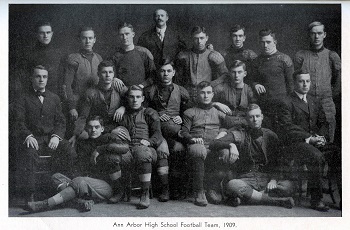 The upcoming 1909 season saw a further tightening of the athletic rules, as the Michigan Schoolmasters’ Association issued strict code that barred paid coaches, requiring instead that a school’s coach must be part of the faculty of the school. In addition, “sweaters and such awards cannot be made to the athletes, only ribbons and banners being given.”
The upcoming 1909 season saw a further tightening of the athletic rules, as the Michigan Schoolmasters’ Association issued strict code that barred paid coaches, requiring instead that a school’s coach must be part of the faculty of the school. In addition, “sweaters and such awards cannot be made to the athletes, only ribbons and banners being given.”
In mid-August, the Detroit Free Press stated that the new rules would be unacceptable to most: “Most of (the state schools) are not prepared, and it looks like a safe bet that the Michigan Interscholastic contenders are not going to chase out some professor that knows football of a few years back and risk their reputations on his game.
“Then there is the matter of awards. The schoolmasters have tabooed the sweaters and that stuff, and will in the future award a ribbon or something similar,” continued the paper. “Where will the big old numeral of days gone by come in? How many football men will play for the honor of the school, and not have the pleasure of sporting the big letter on their manly breasts?”
The new rules, along with complaints concerning the handling of previous tournaments and various other issues, resulted in the final unraveling of the Interscholastic League.
“… Interest in high school football will not decline because of the death of the interscholastic league,” stated a September 1909 syndicated article that appeared in the Benton Harbor News-Palladium and the Grand Rapids Press. “The leading high school teams of the state have banded together in much the same old way and will play for the championship of the state just as though the league or even something better existed.”
With a number of athletes back, Ann Arbor again ended the year with Lower Peninsula laurels. Its schedule included wins over Muskegon, Detroit Central, Saginaw and Grand Rapids. On Thanksgiving Day, the “Purples” defeated Menominee, a power from the Upper Peninsula, 42-0.
“This victory gives the local high school a clear title to the state championship,” stated the Ann Arbor Daily Times News.
The following year saw a major change that eventually would set wheels in motion to create the system of determining football champions we have today.
On Oct. 28, 1910, at the M.S.T.A. convention held in Bay City, a new organization, the Michigan Interscholastic Association, was formed. It served the state’s schools until December 1924, when it was replaced by today’s Michigan High School Athletic Association.
The first MHSAA Football Playoffs were conducted in 1975. The 42nd version of the tournament concluded this Thanksgiving weekend.
 Ron Pesch has taken an active role in researching the history of MHSAA events since 1985 and began writing for MHSAA Finals programs in 1986, adding additional features and "flashbacks" in 1992. He inherited the title of MHSAA historian from the late Dick Kishpaugh following the 1993-94 school year, and resides in Muskegon. Contact him at [email protected] with ideas for historical articles.
Ron Pesch has taken an active role in researching the history of MHSAA events since 1985 and began writing for MHSAA Finals programs in 1986, adding additional features and "flashbacks" in 1992. He inherited the title of MHSAA historian from the late Dick Kishpaugh following the 1993-94 school year, and resides in Muskegon. Contact him at [email protected] with ideas for historical articles.
PHOTOS: (Top) Ishpeming's 1900 football team, the second Interscholastic League champion. (Middle top) Pontiac's 1899 team, which won the first League title. (Middle) Benton Harbor's 1903 championship team. (Middle below) An advertisement tells of the 1907 Saginaw/Benton Harbor final. (Below) Ann Arbor's 1909 championship team. (Photos collected by Ron Pesch.)
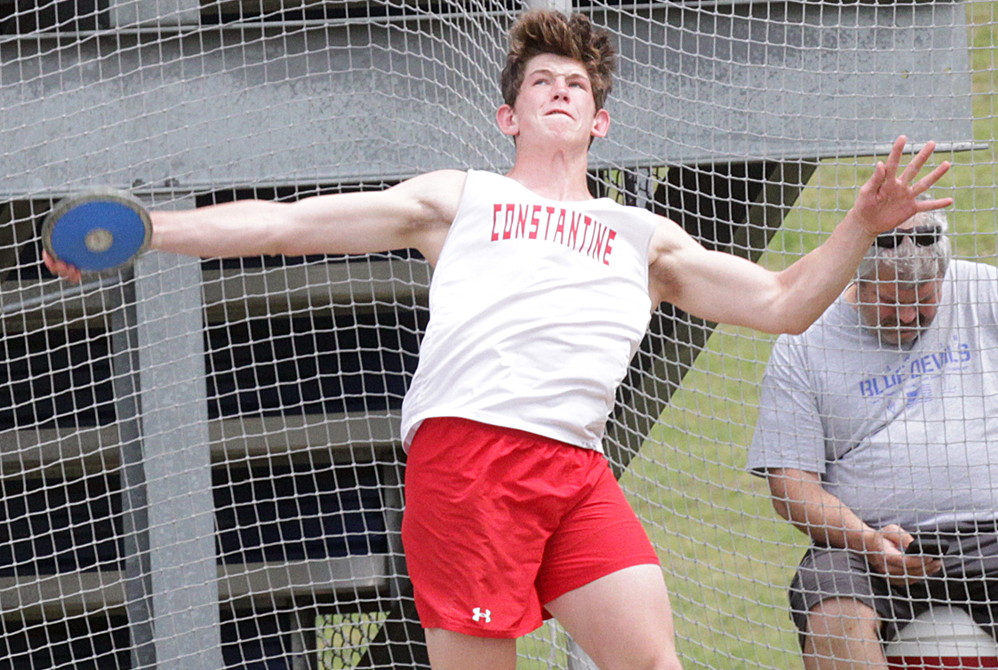
Constantine Football All-Stater, Wrestling Champ Aiming for Grand Finale
By
Scott Hassinger
Special for MHSAA.com
April 30, 2024
CONSTANTINE – Bennett VandenBerg has earned many accolades over the last four years as a three-sport athlete at Constantine.
 But the awards aren't what the 6-foot-3, 240-pound standout will remember most when reflecting on his memories as an all-state football player, state champion wrestler and record-breaking throwing specialist on the Falcons' track & field squad.
But the awards aren't what the 6-foot-3, 240-pound standout will remember most when reflecting on his memories as an all-state football player, state champion wrestler and record-breaking throwing specialist on the Falcons' track & field squad.
"I'll remember how I represented our school and pushed myself to be the best I could be in each sport that I played," said VandenBerg, who has earned 12 varsity letters.
VandenBerg has evolved into one of the most accomplished athletes in the state this school year as a senior, especially standing out among those from smaller communities.
This past fall he was named first-team Division 5-6 all-state at defensive end in football before winning the Division 3 Individual Finals wrestling title at 285 pounds in early March at Ford Field.
VandenBerg's final goal is to win the discus title at the Lower Peninsula Division 3 Finals on Saturday, June 1, in Kent City to end his Constantine career all-state in all three sports.
He broke the school record in the discus his junior year with a throw of 158 feet, 1 inch; the previous mark of 156-6 had been held by Doug Polasek since 1986. VandenBerg has eclipsed his school record twice this spring, most recently with a personal-best toss of 170-9 in a Southwestern Athletic Conference double dual meet with Schoolcraft and Kalamazoo Christian. He ranks No. 4 statewide in the event regardless of enrollment division. Lawton junior Mason Mayne at 175-4 is the only Division 3 competitor with a better throw than VandenBerg.
"It's really cool to have your name up on the school record board, but I'd like to make that mark more untouchable before I'm done," VandenBerg said. "My goal is to be a state discus champion. I've put in the necessary work for it. It would be nice to end my career that way."
Kyle Rimer, Constantine's veteran boys track & field coach, is most impressed with VandenBerg's leadership and presence in working with the Falcons' younger athletes.
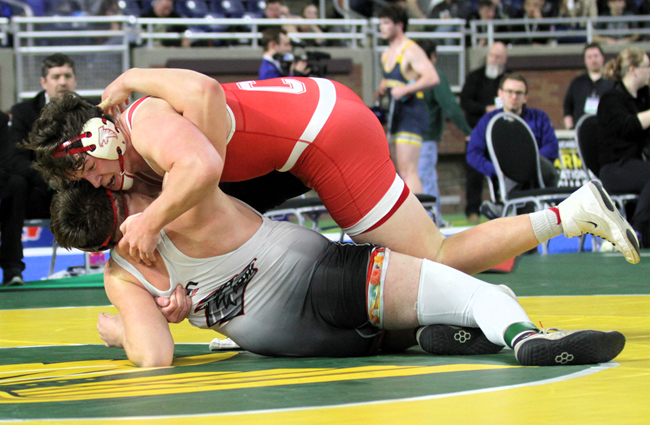 "Bennett loves to compete. Ever since he was a freshman, we've also had him on our 400-meter relay team. That's something he really enjoys doing. He's not just a thrower, but a good overall athlete with lots of drive,” Rimer said. “There's a lot of individuality in track & field, but I think he does a great job of leading the younger kids. He has the drive, accountability and technique to achieve his goal of being a state champion in his throwing events.”
"Bennett loves to compete. Ever since he was a freshman, we've also had him on our 400-meter relay team. That's something he really enjoys doing. He's not just a thrower, but a good overall athlete with lots of drive,” Rimer said. “There's a lot of individuality in track & field, but I think he does a great job of leading the younger kids. He has the drive, accountability and technique to achieve his goal of being a state champion in his throwing events.”
VandenBerg is already a two-time Finals placer in the discus, earning sixth as a junior and seventh his sophomore year. He admits being a little disappointed with his distance at the 2023 state meet.
"In that particular event (discus) you need lots of focus and determination because there are a ton of tiny things you can mess up on that affect your throw. To become better you need to be consistent, show up every day and be willing to put in the work," VandenBerg said. "Right now I'm working on my speed in the circle and quickness in my follow-through."
VandenBerg also has been pleased with his improvement this spring in the shot put. He's increased his distance by over five feet and hopes to break the school record in that event as well. John Kampars (1967) holds Constantine's shot put record at 54-8¼, and VandenBerg's personal best is 48-10 in a double-dual meet this season against Parchment and Centreville.
"Shot put is a difficult event. You need power, but your form has to be top-notch – otherwise it's tough to move that 12-pound ball," VandenBerg said. "I would love to qualify for state in both the discus and shot put and be all-state in each. That would be amazing if I could be a state champion in either of those events."
VandenBerg has put in extra work in the offseason with special instruction from Bill Griffey of Next Throw in Plainwell, along with working with Constantine assistant track & field and head football coach Shawn Griffith.
"Bennett puts a lot of time into working on his throwing. He spends a lot of time in the weight room, and he's a bigger kid who is not afraid to be coached and listens to what other people tell him," Griffith said. "We're excited to see what he can do now that we've had warmer weather recently."
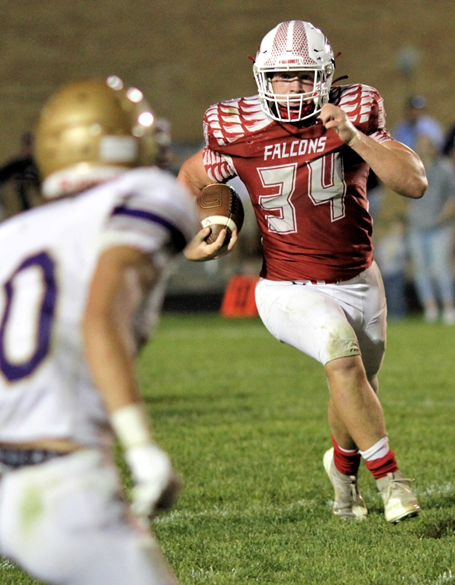 VandenBerg's motivation this spring follows a tremendous wrestling season that saw him finish 54-0 and capture the 285 championship with a 3-0 win in the title match over Reed City junior Wyatt Spalo.
VandenBerg's motivation this spring follows a tremendous wrestling season that saw him finish 54-0 and capture the 285 championship with a 3-0 win in the title match over Reed City junior Wyatt Spalo.
"I gained 20 pounds of muscle and did everything you need to do to become a better athlete to wrestle the heavyweight division. Winning the title was overwhelming. It was everything I ever wanted, and the first 20 minutes after winning it was relief, especially after losing in the Finals as a junior. I just went into that last match and wrestled smart and confident," VandenBerg said. "My speed and strength gave me an advantage over the bigger heavyweights I faced this year."
Vandenberg, 188-22 with 104 career pins, became the 10th Finals champion in Constantine wrestling history and the first to achieve the feat since Kevin Watkins won a 152-pound crown in 2000.
VandenBerg competed at 189 as a freshman and sophomore. He was a Regional qualifier as a freshman and finished sixth in Division 3 as a sophomore before ending his junior campaign as the Finals runner-up at 215.
"Bennett is a competitor who hates to lose, and if he does he learns from it. He had a lot of good practice partners on the team his first three years, and he wasn't going to be denied after losing in the Finals as a junior," said Constantine wrestling coach Dale Davidhizar Jr.
VandenBerg played on Constantine's varsity football team for four years. He got a lot of extra playing time as a freshman when Constantine reached the Division 6 Semifinals during in the COVID-shortened season. He led the Falcons in rushing as a sophomore before switching to tight end as a junior. Out of necessity, VandenBerg returned to lead Constantine in rushing and scoring again as a senior.
"Bennett learned a great deal from the older guys on the team his first three varsity seasons. He learned leadership qualities and is a very unselfish kid who is willing to do what's best for his team," Griffith said.
VandenBerg is most proud of Constantine winning a District crown last fall, especially after his senior class went 0-5-1 as eighth graders. VandenBerg posted 164 solo tackles at defensive end during his final high school season and was Constantine's main offensive weapon with 1,354 yards and 16 touchdowns rushing on 186 carries.
"Winning Districts as seniors in football was a special moment. As eighth graders, we weren't exactly the most athletic team, but we put in the work as we got older to become successful," VandenBerg said.
VandenBerg has been invited to play for the West team at the annual Michigan High School Football Coaches Association's East-West All-Star Game this summer.
College coaches have shown interest in VandenBerg in all three sports, especially football and wrestling. VandenBerg, who carries a cumulative GPA of 3.989 and scored 1110 on his SAT, is weighing his options in athletics but knows he wants to study either ecology or forestry in college.
"I love being outdoors and doing what I love to do," VandenBerg said.
 Scott Hassinger is a contributing sportswriter for Leader Publications and previously served as the sports editor for the Three Rivers Commercial-News from 1994-2022. He can be reached at [email protected] with story ideas for Berrien, Cass, St. Joseph and Branch counties.
Scott Hassinger is a contributing sportswriter for Leader Publications and previously served as the sports editor for the Three Rivers Commercial-News from 1994-2022. He can be reached at [email protected] with story ideas for Berrien, Cass, St. Joseph and Branch counties.
PHOTOS (Top) Constantine’s Bennett VandenBerg competes in the discus during a home meet his junior season. (Middle) VandenBerg, top position, battles Wyatt Spalo in their Division championship wrestling match at 285 pounds in March at Ford Field. (Below) VandenBerg (34) carries the football during a 2023 regular-season home game against Schoolcraft. (Photos by Brandon Watson/Sturgis Journal.)

